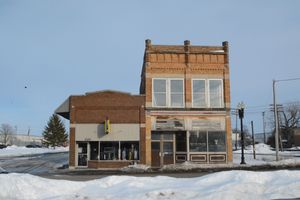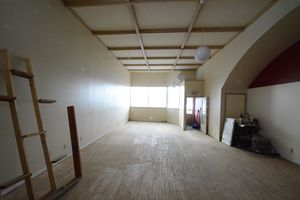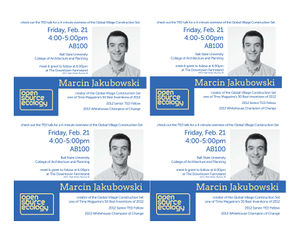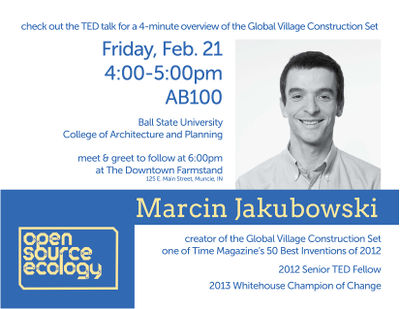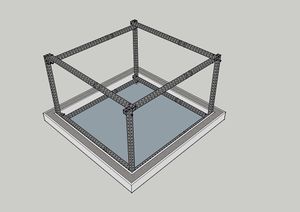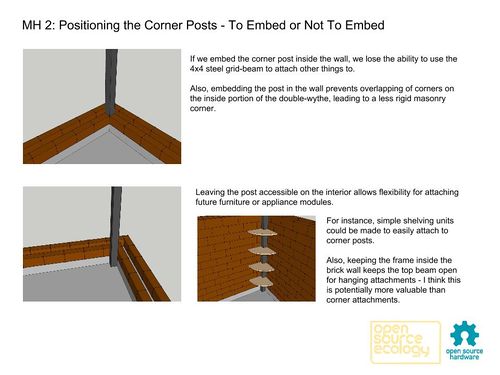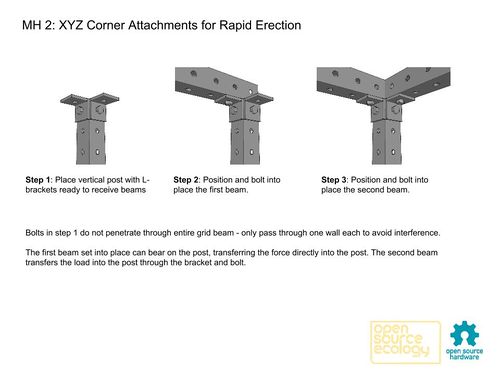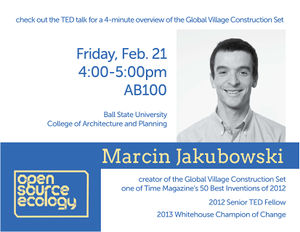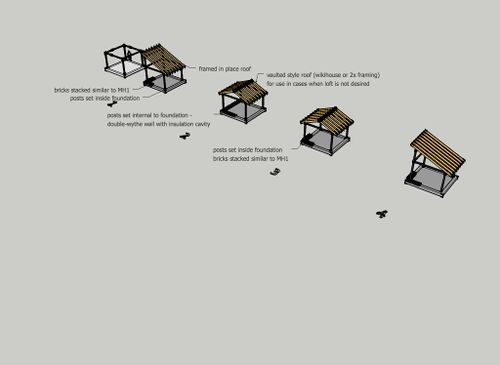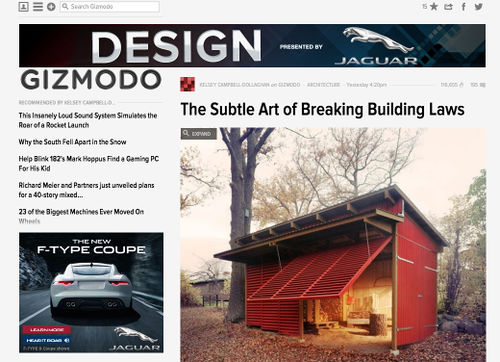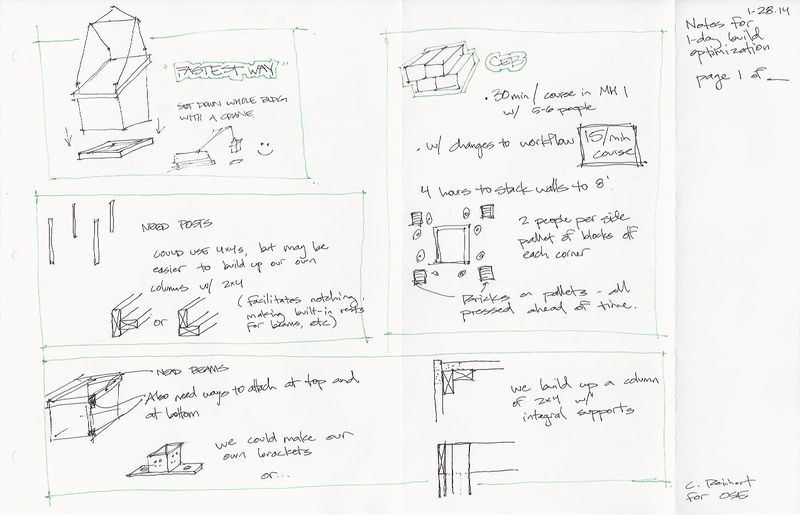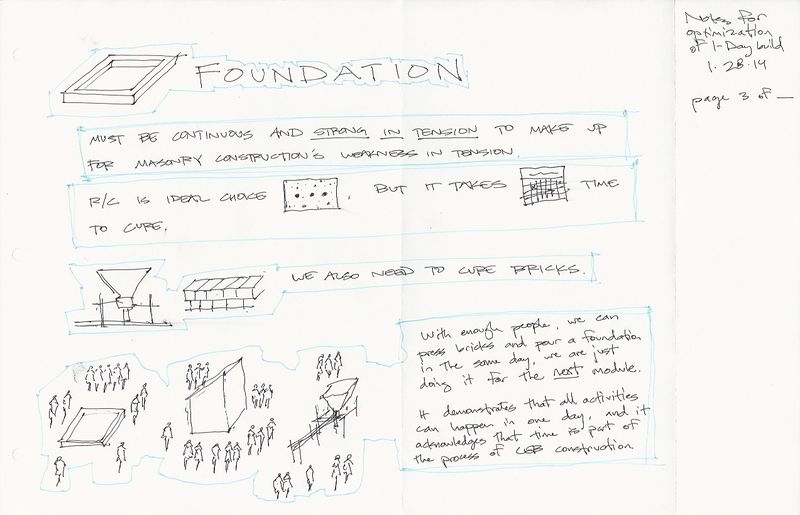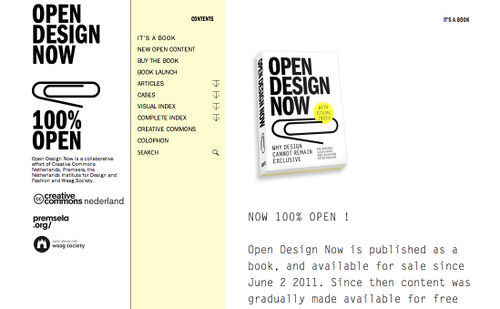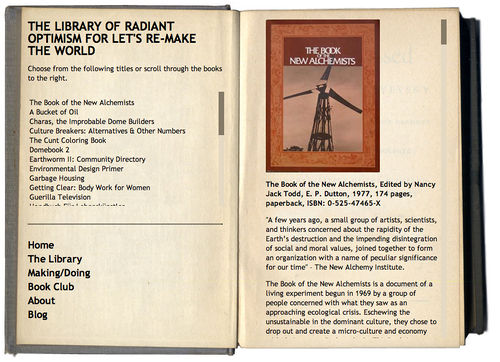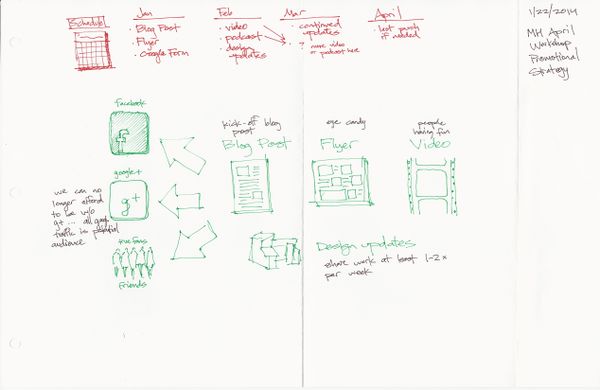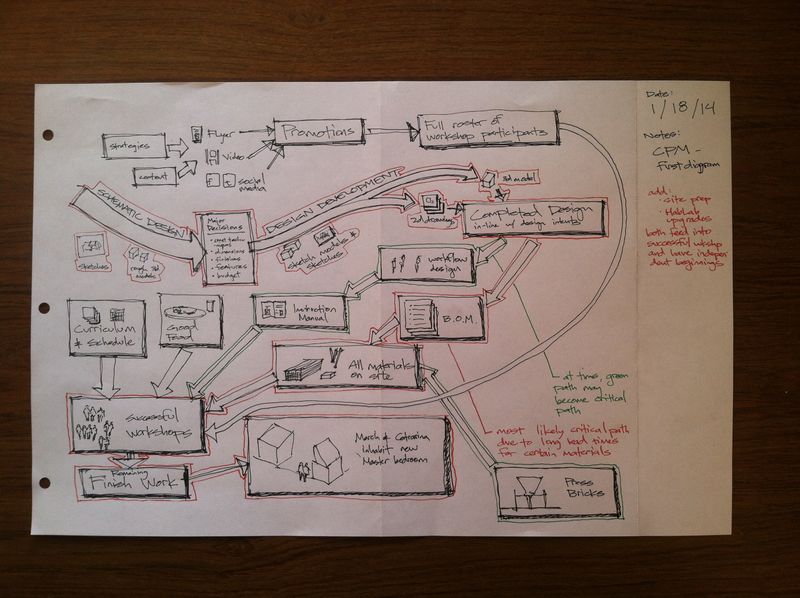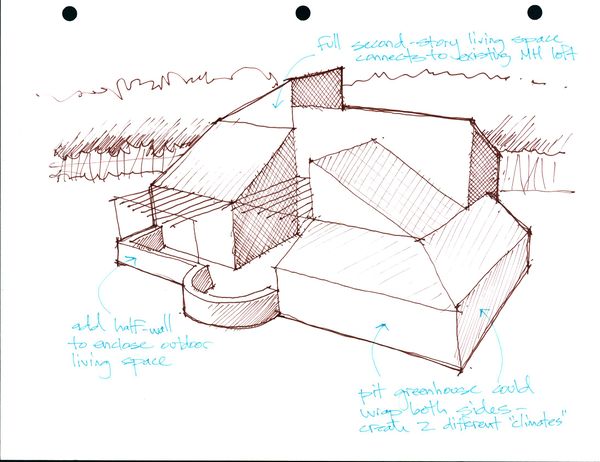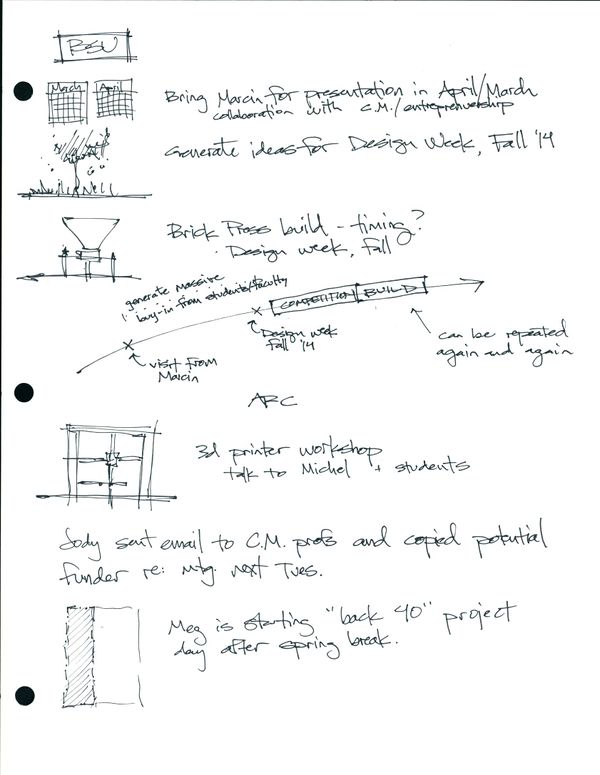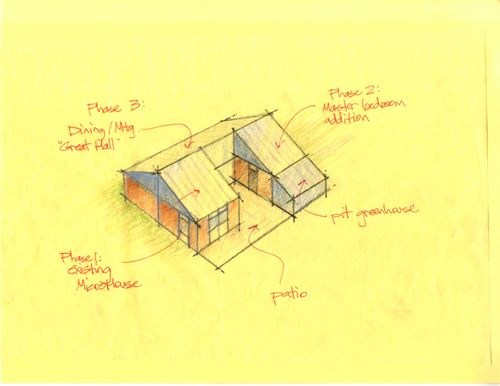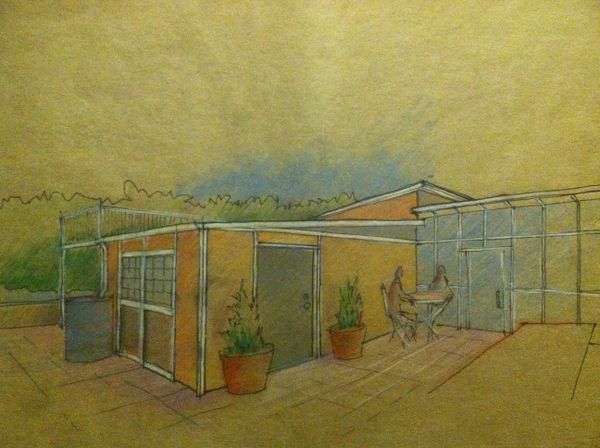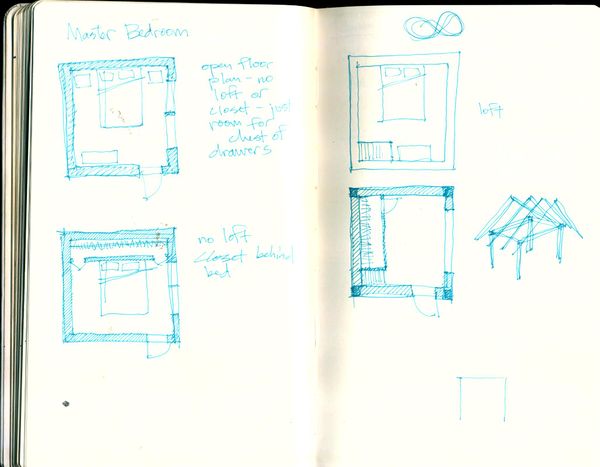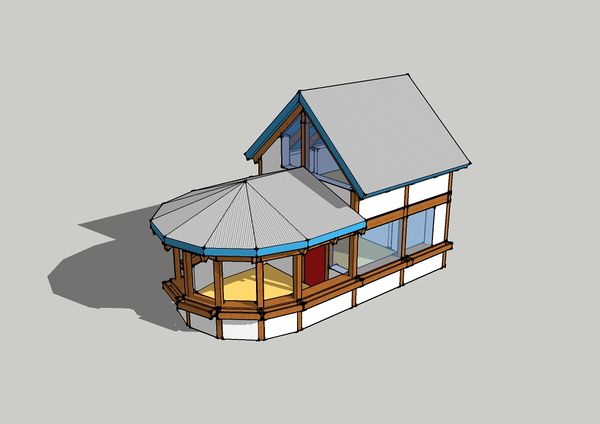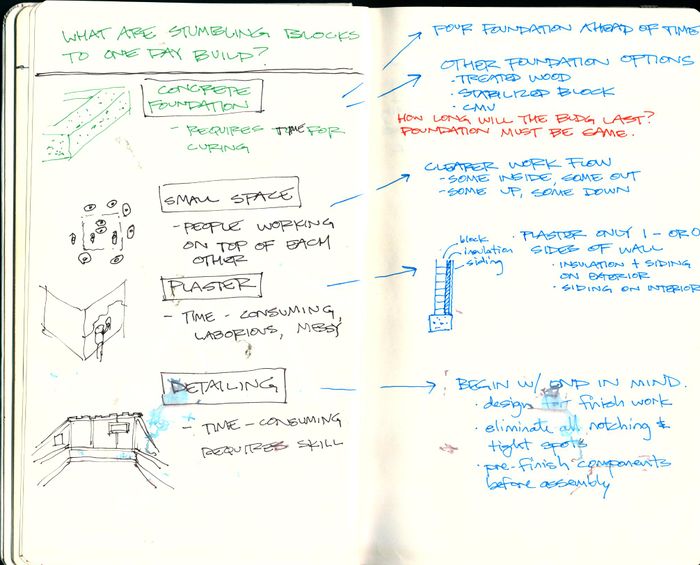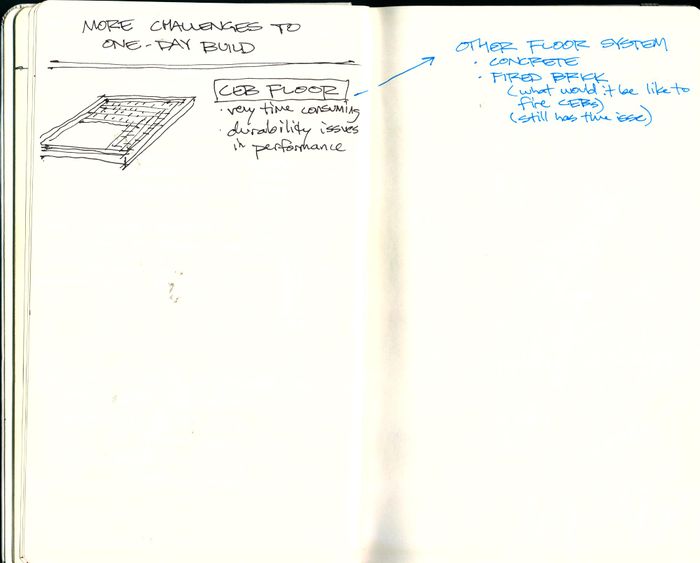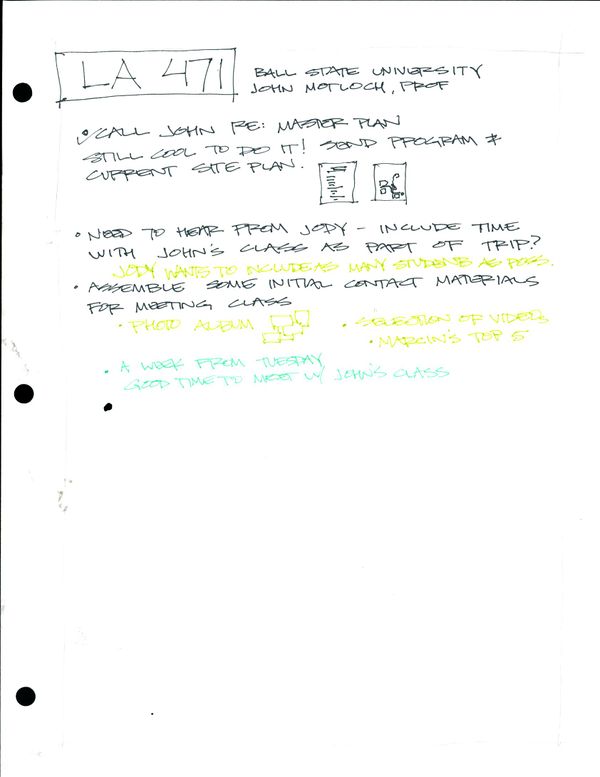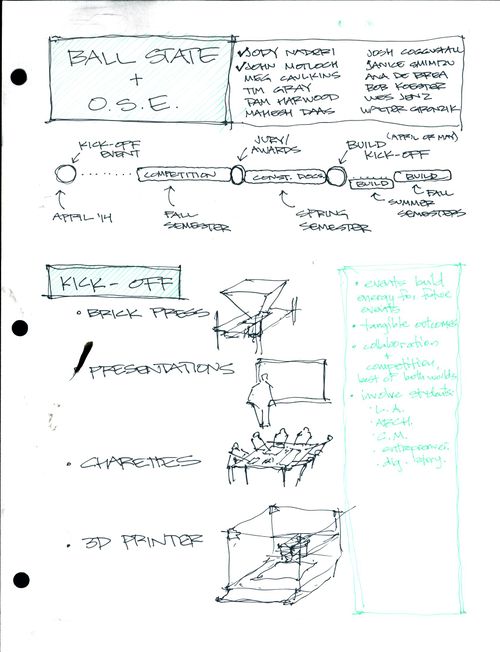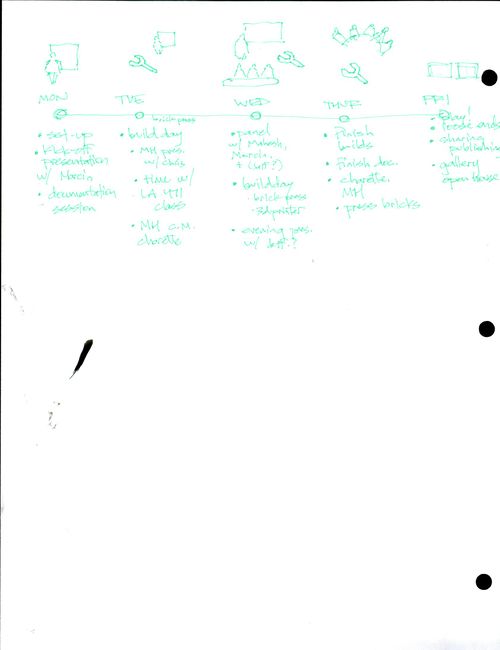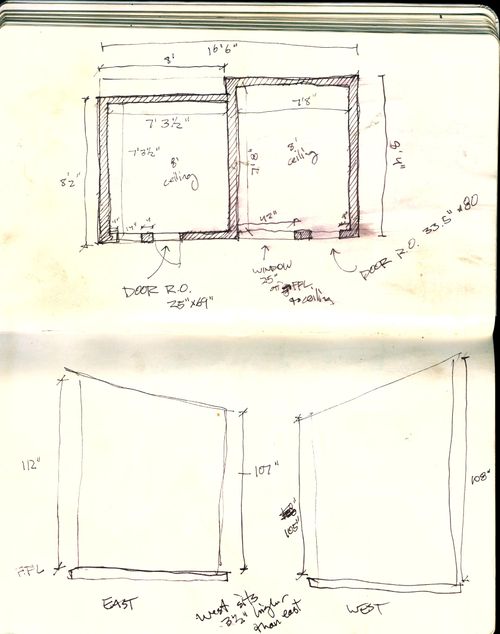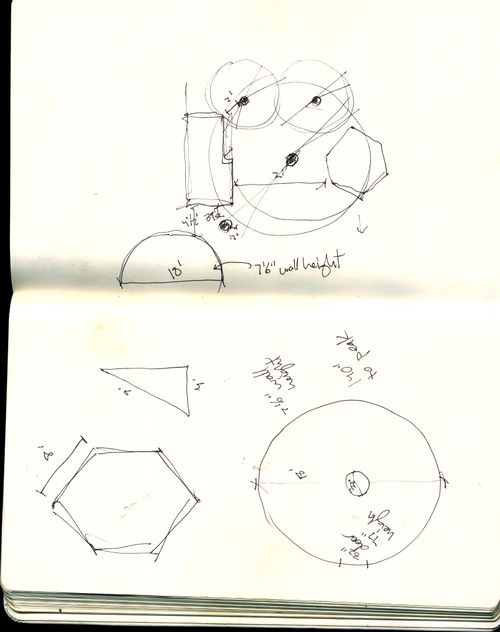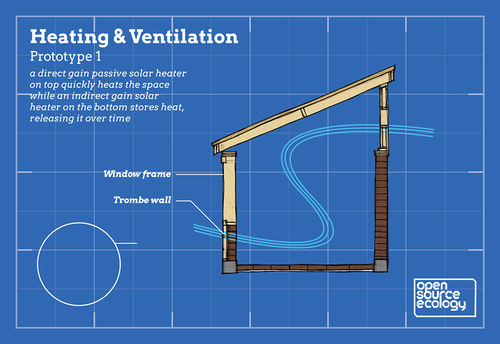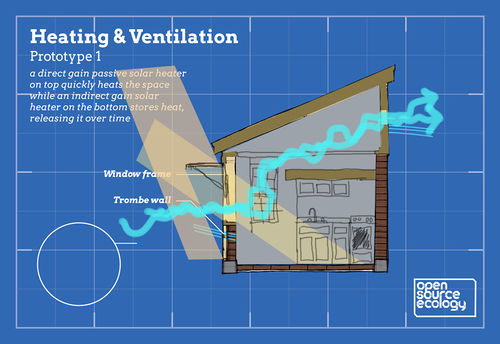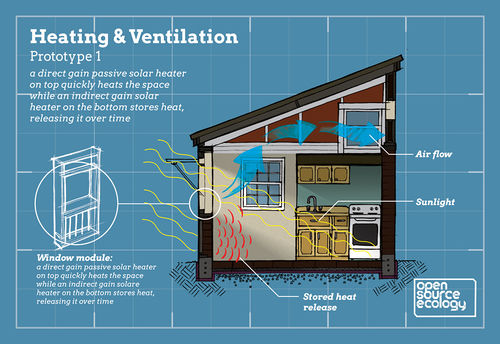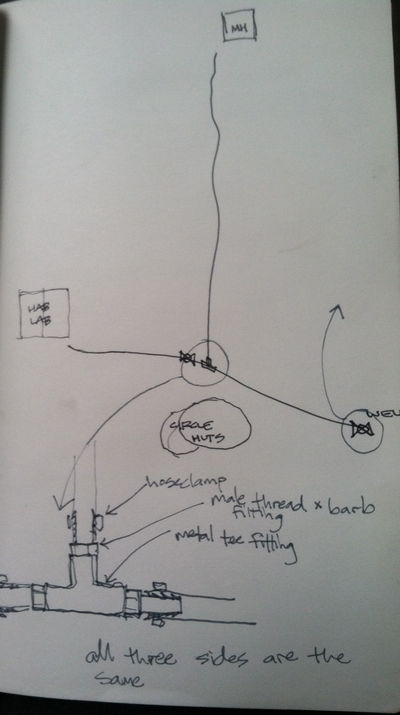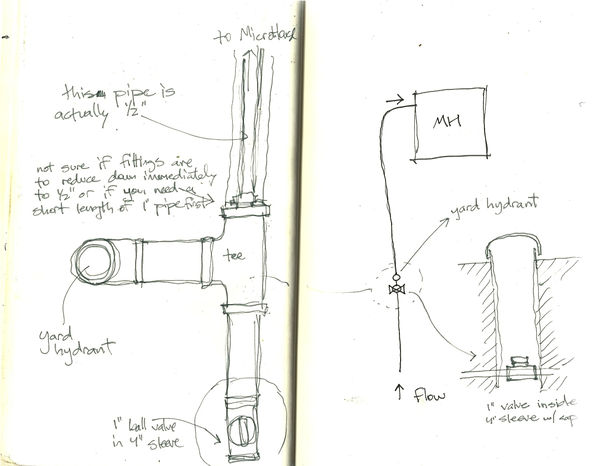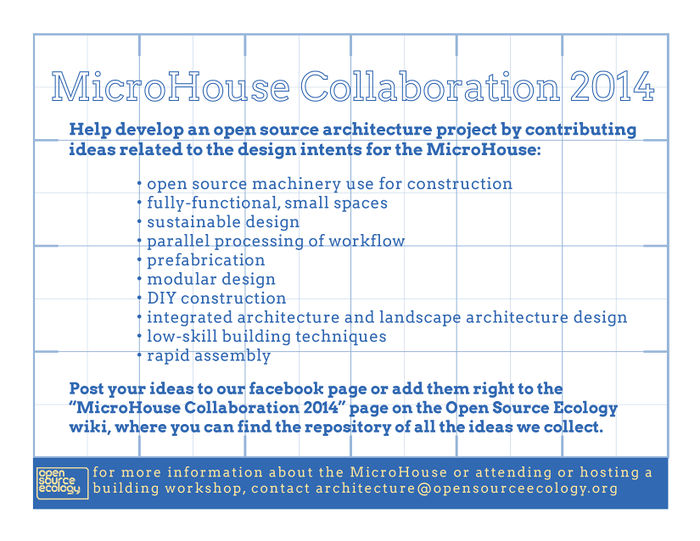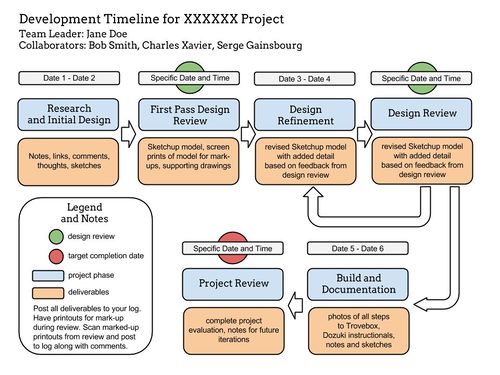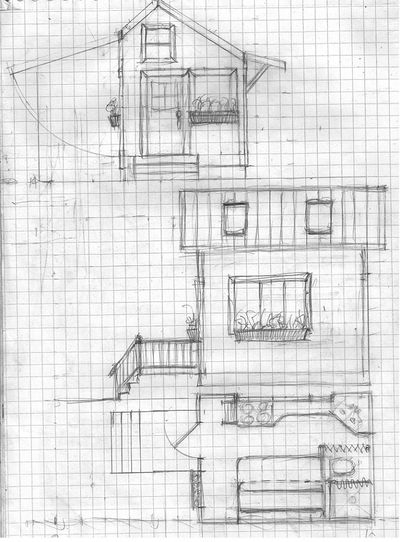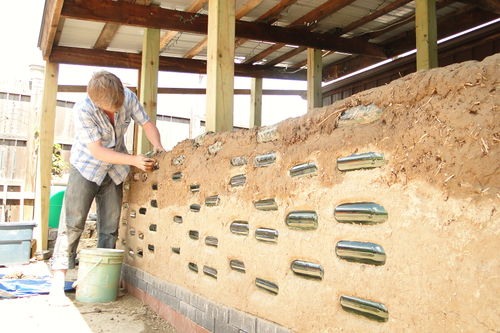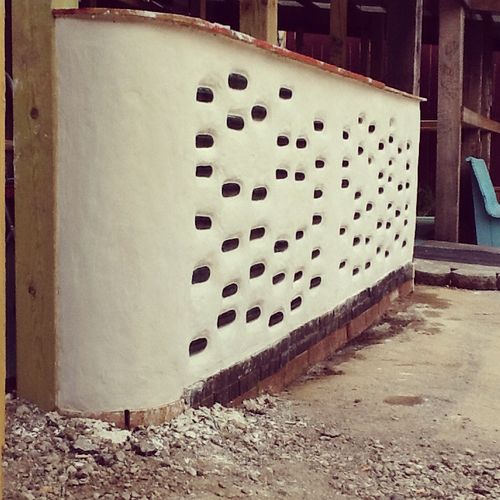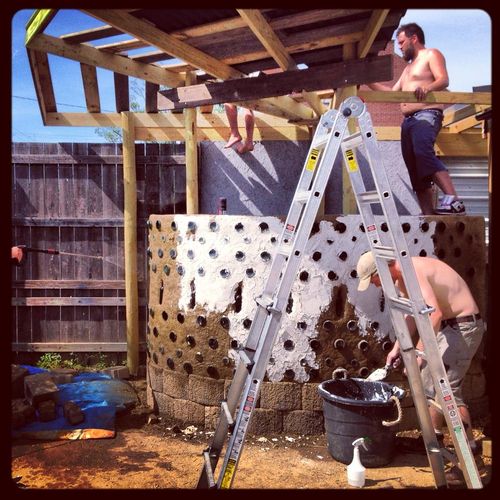Chris Reinhart Log
Tracking My Projects
April MicroHouse Workshop at FeF
Critical Path Diagram/PERT Review
Milestone and Task Review w/ GANTT
Wed, Feb 19, 2014
- Email to Kevin, the farmer interested in mobile MicroHouse, regarding his timeline and interest level in collaboration.
- He is looking to be able to move into the Mobile MicroHouse in two months. (Note: I think that this is too soon for us to devote full attention to it, given our current plans for MH workshops at FeF, but perhaps there is still some means of collaboration or mutual support).
- There is interest from Tim Gray, prof of Architecture at BSU, in collaborating on this project.
- Kevin and I have a phone meeting set for 9am PST next Monday.
- Correspondence with Andrea Swartz regarding establishment of Muncie's first maker-space. Looking to connect her with friends I have on the Muncie Arts Council. A Muncie maker space would be a great place to host OSE builds in the future.
- Location of Purdue presentation confirmed: ME 1051. Link to Purdue campus map. Search for "Mechanical Engineering" to see building location on map.
- Emails and phone call with Justin Richter, PhD candidate at Purdue, to set up presentation there. Time is confirmed for 12:30 - 1:20. Justin will be getting back to me soon on location for the presentation.
- Note: Purdue is creating a Sustainable Communities Group, led by 12 professors from the following disciplines:
- Forestry
- Ag
- Biology
- Civil, Electrical and Mechanical Engineering
- Political Science
- Note: Purdue is creating a Sustainable Communities Group, led by 12 professors from the following disciplines:
- Create step-by-step sketches for stove pipe installation. Link to wiki page.
Tue, Feb 18, 2014
- Set meeting for afternoon with Andrea Swartz to tour "Muncie Makes," a downtown Muncie space owned by the College of Architecture and Planning. Andrea is interested in a potential collaboration on a machine build at this space.
- Continued feeding Catarina information for new website.
- Filled out and submitted TEDxBloomington paperwork.
- Emailed Purdue connections mentioned yesterday as a follow up to James Britton's introduction email.
- Visited downtown building owned by College of Architecture and Planning - Andrea Swartz in leading the refurbishing of this building and is interested in creating Muncie's first Makerspace here.
- Drawing of detail for chimney going through roof. Link to wiki page on insulated chimney
- Hung flyers in BSU College of Architecture and Planning building and hand-delivered them to numerous professors and students.
- Hung flyers in BSU Natural Resources and Environmental Management building.
Mon, Feb 17, 2014
- Contact made with James Britton at Purdue - he spread the word to several other connections (Allen Jacobsen, Kara Salazar, Thomas Voigt, Jovon Rayl,
- Create flyer language and thoughts about BSU alternative spring break details BSU Spring Break Document.
- Printed flyers for distribution at Ball State. (100)
- Created handbills for Marcin's Ball State gig.
- Printed handbills for distribution at Ball State. (120)
Sun, Feb 16, 2014
- Inserted content on my bio page for the wiki.
- Phone conversation with Scott Mader. Details for CEB Press Build confirmed. Payment expected by wire transfer at end of this coming week.
- Answered initial questions posed by TEDx organizer. Link to Document
- emailed potential DPV, Anthony Douglas, re: interview before March visit.
- phone conversation with Anthony Douglas. Set details for his visit. Link to Notes from Conversation on Anthony's DPV Appication.
- Confirmation with Dave Ring, owner of The Downtown Farmstand, that our meet & greet can be held there.
- Flyer changed to include meet & greet. Link to updated flyer.
- Continue reaching out to more professors at BSU to promote Marcin's presentation.
- Ana de Brea, Professor of Architecture.
- Walter Grondzik, Professor of Architecture.
- Dan Overbey, Adjunct Architecture Faculty, Director of Sustainability at BDMD, Indiana Chapter of USGBC.
- Mahesh Daas, Chair of Department of Architecture.
- Sent Catarina info she requested for new website.
- MH April Workshop Flyer
- MH Collaboration Flyer.
- Text: MicroHouse workshops are hands-on, immersive discovery experiences that are fun and empowering. We show participants how open source, DIY hardware can be used to create affordable, beautiful, and sustainable small homes. During these events, we lead participants through the construction of a MicroHouse and teach them the basic design and planning skills necessary to imagine their own. There are many building workshops out there, but something different about the MicroHouse workshop series is that participants become more than just builders, they become actual collaborators in the next iterations of the MicroHouse. For instance, at design charrettes in the evenings of our early-season workshops, we will be improving upon the MH design for workshops later in the year. Attend a MicroHouse Workshop, and build yourself in 2014.
- MH Curriculum Development
- Created XYZ-cube frame.
- See Facebook post for open collaboration with community.
- Download SketchUp file: File:MH 2 XYZ cube w ICF.skp
Sat, Feb 15, 2014
Day off.
Fri, Feb 14, 2014
MicroHouse 2 Development
- Today's sketchup file, as of 5:37pm. File:MH 2 thoughts2.skp
- Corner Post Positioning. Link to drawing of corner options.
- Posted corner thoughts to Facebook for feedback. Link to Facebook post.
- MH 2 Development: XYZ Attachment for Top Corners. Link to drawing of XYZ top corner attachment.
- Posted XYZ thoughts to Facebook for feedback. Link to Facebook post.
Indiana Speaking Events
- Began sourcing venue for after-lecture soiree in Muncie. The Downtown Farmstand, Muncie's local, organic grocer and also farm-to-table restaurant emerges as the top choice. Reaching out through channels to Dave Ring, the owner, to make sure that he has nothing else scheduled for that night. Will Allen of Growing Power recently did a meet'n'greet there, and the turnout was fantastic.
- Placed in contact with Dave Ring by a mutual friend. Sent email to Dave asking for his thoughts on the Farmstand as a place for the meet & greet with Marcin.
- I changed the OSE Wikipedia entry from "Open Source Ecology (OSE) is a network of farmers, engineers, and supporters.." to "Open Source Ecology (OSE) is a network of farmers, engineers, architects and supporters..." to reflect our growing number of contributors in the architectural realm. OSE Wikipedia Page.
- Shared Facebook post on my personal timeline to continue reaching out for setting up Purdue presentation. Link to Facebook thread on my personal timeline.
- Attracted attention of Barry Knechtel (high school friend), who has offered support. Phone call with Barry - he recommends connecting with James Britton (another high school friend) who is director of social media communications for Purdue student groups. Barry is sending me James' contact info.
- Friend, Isaac Emery, recent PhD graduate of Purdue sent email introduction to Drs. Lee and Nies.
- Email and phone communications with the following individuals to promote BSU presentation:
- Tim Gray, Professor of Architecture.
- Dr. Wes Janz, Professor of Architecture.
- Lori Pence, Assistant to the Assistant Dean of CAP.
- Michel Monayaur, Assistant Dean of CAP. - will be attending portion of presentation but has partial conflict due to event with his daughter at same time. Not available after the presentation due to this event. Is interested in meeting before presentation, if we end up with time in Muncie.
- Jody Naderi, Chair of Landscape Architecture Dept.
- Andrea Swartz, Professor of Architecture.
- John Motloch, Professor of Landscape Architecture.
- Scott Truex, Professor of Urban Planning.
- George Elvin, Professor of Architecture.
- Meg Caulkins, Professor of Landscape Architecture.
Thu, Feb 13, 2014
- Delivered initial presentation to John Motloch's LA471 Class. Click for lesson plan.
- Created flyer for Marcin's presentation at BSU, Friday, Feb 21. Link to flyer.
- Connected with Isaac Emery, recent PhD graduate of Purdue University. He is reaching out to Dr. Loring Nies and Dr. Linda Lee, two potentially receptive faculty. Michael O'Donnell, Purdue grad and organizer of the Indiana Small Farms Conference recommended Dr. Nies, as well.
- Posted BSU flyer to Facebook with inquiry about setting up Purdue presentation, as well. Link to Facebook post.
Wed, Feb 12, 2014
- Conversation with Tom and the Pool factory. Notes from conversation.
- Phone meeting with Marcin and Russ from Kakwa Ecovillage re: workshop series. Notes for next steps added at end of google doc.
- Conversations with numerous faculty and students to ensure a good turn-out for a possible Marcin presentation on Friday, Feb 21. Professors that have committed to attending themselves - those marked with asterisks will also be bringing their students are: Wes Janz*, Andrea Schwartz*, Ana de Brea*, Bob Koester*, John Motloch*, Scott Truex, Simon De Bouvier, Josh Coggeshall. This ensures a turnout of 50+. I believe, with some more promotions on my part, I can make the number over 100.
- Began work on construction possibilities for steel tubing with MH build. Noticed that steel tubing warehouse parts or modeled with far too many surfaces - one 8' long piece has over 9000 entities! This causes models to bog down fast. For now, I have been modeling with just 4x4 solid extrusions (which have 18 entities each) so the model does not get "laggy." We need to remodel all the warehouse pieces so that the circles do not have 24 sides each - circles with 8 or 12 sides each which reduce the number of entities in the 4x4 tubes by 60% or 50%.
Tues, Feb 11, 2014
- Travel to Muncie in morning.
- Delivered presentation on DIY-housing and MicroHouse to permaculture class in afternoon. Four interested students. Two potentially interested in cooking for spring break trip.
- Pool discussion with Marcin and Catarina in evening.
Mon, Feb 10, 2014
- Process hand-written notes from first group conversation with Russ, Marcin, and me. Link to notes from conversatin on 1/21/14
- Began adding Tumbleweed information to Mobile MicroHouse wiki page: link to Mobile MH page
- Create proposal for Russ at Kakwa with Marcin. Link to Proposal prepared as starting point for detailed conversation with Russ
- Grammar lesson with Marcin ;)
Sun, Feb 9, 2014
Weekly Planning
- Create presentation for Indiana Small Farmers Conference.
- Create promotional strategy with Emily and ED, approve budget.
- Finish scripts for MicroHouse into as prelude to MicroHouse Collaboration. This needs to happen fast, and is actually, now that I think of it, the same as preparing for the Indiana Small Farmer's Conference and the TEDx talk, which I need to be turning in initial information for.
- Talk over BSU alternative spring break funding ideas with Marcin.
- Recruit students (and professors to refer students) for BSU alternative spring break
- Create rough foundation plan and timeline for building projects for entire season.
- Finalize plans with Scott Mader for brick press build.
Completed January Self-Review
Logging Have you kept a regular log? Comment on any irregularities or missed days.
- Beginning of month was weak - fell out of habit at the end of 2013 with the holidays. Work product from those times was captured in bulk entries for end of 2013 and early 2014. Also, these past few days in California it has been difficult to keep up with the log as the trip to southern Cali has been a whirlwind of meeting people and long conversations with them late into the evenings.
Have you posted all your work product in your log?
- Minus about a dozen pages in my sketchbook, yes. Will scan them when I return to Indiana.
- Still haven't scanned them.
Have you done weekly planning and review? How was that useful?
- I have kept checklists in my binder, as I typically do. For February I will begin making this more transparent by putting such information on my log.
- See Weekly Planning above.
Self-Assessment Were your goals and role clear to you?
- Yes.
What are your main accomplishments for the month? List 3-5 and include links.
- Milestones spreadsheet setup
- CPM Diagram
- Positive Networking and Community Building in Southern California (among other places)
- Chosen as TEDx speaker to tell the story of Reinventing the Barnraising
What worked for you this month?
- Made many new positive connections
- Gained clarity and focus for workshop planning as a result of planning tools.
What didn't work, and how could it be improved?
- Frequent travel during winter time is less than ideal.
What are your main 3-5 milestones for next month?
- Develop MicroHouse Collaboration to a new level of collaboration and openness.
- Recruit 8+ awesome students for BSU Alternative Break
- Register first participants for MH April workshop.
- With ED, create plan for soil mixer implementation during BSU spring break. Marcus?
- Give effective presentation at Indiana Small Farms Conference introducing OSE, the GVCS, and other open projects like Farm Hack.
What is the major milestone that you'd like to say you accomplished after this coming month?
- Create a collaboration with BSU students that begins open design project even before spring break trip and culminates next month with a highly productive and enjoyable experience by everyone involved.
Open Collaboration How are you using open tools, publishing all your results on an ongoing basis? How are you communicating your progress via OSE social media?
- Using log on wiki, and beginning to grasp understanding of the log's relationship to the rest of the wiki. Will be providing far more links to content added to other parts of the wiki, rather than just filling my log.
What measures are you taking to invite collaborators to work with you or with OSE?
- Ongoing development with BSU profs, to an ever-expanding circle. Consistent promotion of our work through numerous personal channels in the Indiana permaculture and small farm scene. Beginning to more regularly attend BloomingLabs. I feel like I am laying the groundwork for long-term, meaningful relationships.
Who have you collaborated with this month outside of the Factor e Farm team?
- at Ball State University: John Motloch (work with LA 471), Jody Naderi (long-term planning for big event), Tim Gray, Andrea Schwartz.
- at U of MN: Molly Reichert (planning visit for Marcin in March)
- in San Diego: Scott Murray and Jerry (educational center in Encinitas)
- Kevin, interested collaborator as first owner of mobile MicroHouse - introduced through Scott Murray
How would you assess the achievements of the other members of the core staff and other key team members?
- Rob kicked ass at the 3d printer expo - very exciting developments with the 3d printer workshops.
- Marcin has been doing awesome on the college tour. I'm excited for the U of MN, and also still hoping to bring him to BSU and Purdue, as well.
What other measures could you try next month to enhance the open collaboration aspects of your work?
- Keep reading Open Design Now and develop MicroHouse Collaboration with this inspiration.
- Reach out more and create new venues for conversation on development of MicroHouse and Mobile MicroHouse.
- Film project reviews and critiques with experts like Ralph Bicknese, Bob Berkebile, and other experts. Also, participate in design charrettes with various student groups and then feedback that story to the open community. Consider myself the curator of the MicroHouse Collaboration, rather than the design of the MicroHouse itself. Generate specific problem statement as the essential tool to frame the collaboration.
Project Planning Has your Critical Path Diagram been useful? Are you meeting your Critical Path objectives?
- No, it was not as useful as the spreadsheet, but perhaps it is because it was out of chronology. Now it may be more useful. Falling behind on design development as a result of travel to Southern California as well as funding uncertainties.
How has your Tasks spreadsheet helped you? What do you like about it, and what isn't working?
- Embedding links on the timeline helps me keep track of things, and I find the comments a useful way to communicate.
How confident are you about your financial planning - how well does it/is it expected to meet reality? Is your risk assessment clear?
- With the investment of some money, and a focused effort on my part, I believe that we can build the MicroHouse workshop track to a financially sustainable model by the end of the year.
- I think July may realistically be our first positive month, but from there I think we will be good.
- My TEDx talk will help reach a broad enough audience and provide an informational piece for the right type of person, to help reach the goal of 12 people per workshop.
Has the project been on budget? How effectively is spending being converted into mission-critical value for OSE? What costs (time, money, materials,.) can be reduced or optimized?
- Yes, but there has been zero money spent.
- There will need to be money spent on this in the very near future. We should ask Emily's advice on this matter and follow it rigorously.
- Filling the workshops means engaging with our present audience on Facebook and reaching other parts of our audience through the internet in other ways.
- This is all well within our grasp, but it will involve the approval and spending money.
- My gut is that it would be between $500 and $1000, but I have no experience buying social media or internet advertising.
Mon, Feb 3, 2014
January Self-Review
Logging Have you kept a regular log? Comment on any irregularities or missed days.
- Beginning of month was weak - fell out of habit at the end of 2013 with the holidays. Work product from those times was captured in bulk entries for end of 2013 and early 2014. Also, these past few days in California it has been difficult to keep up with the log as the trip to southern Cali has been a whirlwind of meeting people and long conversations with them late into the evenings.
Have you posted all your work product in your log?
- Minus about a dozen pages in my sketchbook, yes. Will scan them when I return to Indiana.
Have you done weekly planning and review? How was that useful?
- I have kept checklists in my binder, as I typically do. For February I will begin making this more transparent by putting such information on my log.
Self-Assessment Were your goals and role clear to you?
- Yes.
What are your main accomplishments for the month? List 3-5 and include links.
What worked for you this month? What didn't work, and how could it be improved? What are your main 3-5 milestones for next month? What is the major milestone that you'd like to say you accomplished after this coming month?
Open Collaboration How are you using open tools, publishing all your results on an ongoing basis? How are you communicating your progress via OSE social media?
What measures are you taking to invite collaborators to work with you or with OSE? Who have you collaborated with this month outside of the Factor e Farm team?
- at Ball State University: John Motloch (work with LA 471), Jody Naderi (long-term planning for big event), Tim Gray, Andrea Schwartz.
- at U of MN: Molly Reichert (planning visit for Marcin in March)
- in San Diego: Scott Murray (
How would you assess the achievements of the other members of the core staff and other key team members? What other measures could you try next month to enhance the open collaboration aspects of your work?
Project Planning Has your Critical Path Diagram been useful? Are you meeting your Critical Path objectives? How has your Tasks spreadsheet helped you? What do you like about it, and what isn't working? How confident are you about your financial planning - how well does it/is it expected to meet reality? Is your risk assessment clear? Has the project been on budget? How effectively is spending being converted into mission-critical value for OSE? What costs (time, money, materials,.) can be reduced or optimized?
Fri, Jan 31, 2014
Fantastic day of learning and networking at the 3d Printer World Expo. More than 1/3 of the 3d printer market is open source, so there were many kindred spirits there. Captured some short video with the guys from Not Impossible Labs as well as MatterHackers - which I will be posting on Facebook once I have a chance to download it and trim the ends.
Also, randomly came across the Open Design page on Wikiversity and noticed that Open Source Ecology was not on their list of external links, so I added it. Wikiversity External Links Section
Thu, Jan 29, 2014
Wed, Jan 28, 2014
Article:Creatively Breaking Building Codes
Great article on various ways people get around restrictive building codes in different parts of the world. Posted this link as a response to the comments thread regarding building codes on one of our facebook posts.
http://gizmodo.com/the-subtle-art-of-breaking-building-laws-1510684885
Arrived in Burbank
Rob's notes from yesterday evening's conversation: "Chris Arrived. Great discussions on everything from details of workshops to larger philosophy questions. Some important discussion points (in no particular order): Nature and "promise" of experimental workshops Necessary infrastructure and tools for workshops. Positioning to the world of workshops - open source etc. DPV's in the new model San Diego connectivity for workshops and builds Driving with Emily Aiken to San Diego this morning for meetings with Scott and Jerry."
Tuesday Jan 27. 2014
MicroHouse Optimization
General Ideas - Framed Structure to work on more parts at the same time.
Fasteners - Much of the time in the construction process has to do with fastening.
Foundation Ideas - Parallel work on NEXT foundation and CEB pressing for honest "1-day"
I think there is some very interesting potential in combing the MH and the WikiHouse. Been toying with a SketchUp model...
Create a shorter WH that can set on a quickly erected post and beam frame that bricks are then filled up to underneath.
Or perhaps we can create a framing system of WH-style pieces, too, but just with corner pieces and door/window pieces.
Mon Jan 26, 2014
Sat January 25, 2014
Research: Open Design Now, Book
So happy to have stumbled across this book!
"Can open design allow designers to reclaim the moral high ground and put solutions to those problems in place?" -Marcus Fairs
One of the most intriguing questions asked in this video summary of the Open Design Now book release. All the content can be read online for free. Book is available in print, as well. A good model for how we might do our guides to the various products.
Book Launch Video
- Very fun and diverse collection of clips.
- 6:30ish interesting urban planning perspective - "From WOW design to WE design."
- 8:48 - Prosthetics fablab in India.
Preface, by Bas Van Abel, Lucas Evers & Roel Klaasen
http://opendesignnow.org/index.php/article/preface-bas-van-abel-lucas-evers-roel-klaassen/
Notes:
- Book project initiated by three groups: Creative Commons, Netherlands; Premsela, Dutch Platform for Design and Fashion; and Waag Society.
- "Using key texts, best practices, and a visual index, we sketch a picture of open design based on the knowledge and experience of the present moment."
- Book was the outgrowth of the (Un)limited DesignContest, "an open design experiment."
- book provides an overview of "best practices in 'creative innovation,' as Waag Society calls it. Or perhaps we should call it 'social and participatory innovation,' since the term refers to the continuous search for meaningful applications of technology and design that will benefit the general population."
Introduction, by Marleen Stikker
http://opendesignnow.org/index.php/article/introduction-marleen-stikker/
Notes:
- "The pioneers of our time are not taking the world at face value, as a given from outside; rather, they see the world as something you can pry open, something you can tinker with."
- The difference between possibilitarians and realitarians: "new opportunities, even if they do not know where they might lead" vs. "accept the conditions and the institutions as given, and are fearful of disruption."
- That said, "Whether a person is a possibilitarian or a realitarian has nothing to do with their creativity. People representing these frames of reference can be found in all professions: entrepreneurs, politicians, artists."
- "Possibilitarians see the disruption that open design brings to the design world, and respond by embracing the potential that is inherent in that disruption."
- "Possibilitarians engage in open design as a process, trusting their own abilities to guide that process. And as possibilitarians, they pursue strategies to be inclusive, to involve others, to build bridges between opposite positions: North-South, old-young, traditional-experimental. Possibilitarians represent a sharing culture which is at the core of open design. As such, they trust others to make their own contributions and to build upon what has been shared. Trust, responsibility and reciprocity are important ingredients in an open, sharing culture."
- "as with open data, open design will have to involve the actual end users, not organizations, panels or marketers."
- "Open design will have to develop its own language for trust. What are its design principles, its ethics, the responsibilities it entails? "
- "Open design can be viewed as the latest in a long line of similar developments, starting with the first PCs – the Ataris, Amigas, Commodores and Sinclairs – the arrival of the internet, of mobile communication. TREND:NETWORK SOCIETY It is often the same people who are involved in these initiatives again and again. These are the pioneers of our time, people with that hacker- artist-activist attitude. They are not taking the world at face value, a given from outside; rather, they see the world as something you can pry open, something you can tinker with."
- "Open design is rooted in information and communication technology, giving us all the instruments to become the one-man factory, the world player operating from a small back room. Despite this semblance of easy access, many of these resources require the user to be extremely tech-savvy. In addition, purposeful and effective utilization of these resources requires considerable social skills and expertise in social engineering. This combination of technical and social skills is extremely interesting and very rare. Tech-savvy usually carries the connotation of nerdy, socially handicapped and awkward at communication, while the socially adept are generally assumed to lack technical skills."
- "In fact, it may be argued that there is a fundamental dichotomy in society, an essential separation between the field of making and the field of science. There is too little science in making, and too little making in 18 science; these two fields are far too disconnected."
- "Examples of the opposite are emerging, and the connection between modern technology and craft traditions is sometimes aptly named hyper-craft. The implications for education are huge, and hyper-craft broadens the perspectives in education – not only for design, but for all crafts. Hyper-craft as a practice of open design is not primarily concerned with the objects that are being made. Its focus is on the process of making itself and the responsibilities that makers take – for the monsters they may be creating, for the process of creating, and for the ingredients used."
- MORE RESEARCH INTO THIS EXAMPLE "Recently, a vocational school in the Dutch province of Brabant took the idea of the Instructables Restaurant and used it as a blueprint for a cross-over programme that combined elements of their hotel and catering education and their design education. Together, they realized an Instructables Restaurant for the CultuurNacht event – students created furniture based onblueprints BLUEPRINTS theyhaddownloadedand cooked meals prepared according to online recipes. The restaurant served 1500 people that night. The school made a smart addition to the very classical trade of cooking, adding more dimensions, more layers, and creating their first open curriculum."
- "When international trade agreements become a guise for Western corporations to privatize indigenous knowledge, activists and librarians deploy open design strategies, documenting and codifying this knowledge and developing protection mechanisms such as the Aboriginal and Torres Strait Islander Library and Archive Protocols in Australia."
Research: The Library of Radiant Optimism for Let's Re-Make the World, Online Resource
Holy cow! What a jackpot - incredibly interesting literature review of classic texts on living in harmony. It is so much fun to flip through these virtual pages.
I've read some of the texts on the list (Christopher Alexander and Lloyd Kahn) and numerous other titles here are of interest to me. At the top of the list:
- Culture Breakers: Alternatives & Other Numbers, Ken Isaacs, New York: MSS Educational Publishing Company, 1970, 190 pages
- Nomadic Furniture, By Victor Papanek, Pantheon, January 12, 1973, 149 pages, paperback, ISBN: 039470228X
- How To Build Your Own Living Structures, By Ken Isaacs, Harmony Books, 1974, 136 pages, sprial bound, ASIN: B0006C58MM
January Self-Review
Bullet Point Review
- Excellent setup on spreadsheets for MH April Workshop, good out-of-the-gate discipline on filling in the spreadsheet. Good progress on initial workshop tasks.
- Need to transfer information to Development Board.
- Back in good habit of using personal log - exploring new formats of logging - like bullet point lists :)
- Continued solid development with Russ at Kakwa, Jody at BSU, and Molly at U of MN, and expanding to Andrea Schwartz, Meg Calkins, and Tim Gray at BSU, as well.
- Decent interaction with Facebook in January, but much room for improvement - ties in to comment about storytelling below.
- Decent schematic design progress immediately upon Marcin and Catarina's return but need much more effort in this area in the coming days and week. See timeline - schematic design set to end January 30. Plan for phone calls with Marcin and Catarina early in next week. Mon/Tues evening?
- Opportunities opened earlier in month for potential MicroHouse build with Tyler and Amanda in Georgia. Opportunities to be uncovered in several days on trip to California - site visits and meetings with other collaborators hosted by Frank Golbeck and a separate trip to another connection that Rob has set up, but also in San Diego.
- Poor storytelling of MicroHouse development. Interior shots at Christmas was first hint that I have not communicated the design intents effectively with the public. Recent Facebook comment reinforces that.
Goals for Feb
- Continued discipline with use of spreadsheets and tracking tools.
- Improve use of Development Board.
- Create numerous presentation materials/modules for MicroHouse. These will be used on the web to educate our friends and collaborators, which will in turn, lead to a better openly developed product.
- Post these educational materials to Facebook. Begin using Google+.
- Parallel develop workshop curriculum - will use many of the same media as above, just in different form.
- Move from schematic design into design development for MH additions - radical optimization of 1 day build.
Telling the Story of the MicroHouse
From the time the initial MH build sprint concluded to the present moment I have been doing a poor job of telling the story of the MicroHouse, what we set out to do, where we went right and what we will be doing differently next time. It is easy to get caught up in the other tasks of research, development, planning, and of course all the day-to-day tasks like email and meetings. These are all beneficial activities (and working with OSE means the big picture values are very much present in the routine tasks), but what often falls short is the last mile of documentation.
A recent Facebook post drove this point home for me. Anyone that puts their work out there on the internet knows that the arrows start flying right away when you do. Marcin made the following post:
And this was in the comments:
insert screenshot
It stung because many of his references are similar to mine, but I have been through architecture school and developed the mindset to be vulnerable and open to critique. (As a side note to design students: You are paying for good critique from your professors. Be open to it. Learn from it. There are times to dig in your heals, but when you can separate your ego from your project, you can have a better project. A good designer can absorb the critique and weave into the project to make it stronger, not to dilute it. A good designer knows how to discern and utilize the critique that betters the project.)
The critique that this guy who wants to build his own small house, and has obviously done some good research, got nothing from our project except not how to build tells me I have not done the documentation well enough. I realize that when I just put pictures on Facebook with a short comment that might explain what the viewer sees, I fail at telling the story of the MicroHouse. The pictures of the product are less important than the process we explored to get there.
This is the untold story. What sorts of workflows did we use, how well did they work, which will we use again, what didn't work, etc. The way the MH looks is entirely a function of how we wanted to put it together.
So, the main part of my self-review is that I need to better tell the story of our ambitious goal: re-imagining the barn-raising into a one-day cottage-raising for the 21st using all open source hardware. This means going beyond using just the tractor/pulverizer/brick press combination into using existing OSE machines like the saw mill and forthcoming machines like the strawboard press. Eventually, I want to make the nails and glass, too, but we're taking this thing one step at a time :)
Friday January 24, 2014
Notes on social media in general:
- We need to begin using Google+ as another outlet to get our information in the hands of our friends. Google+ is directly tied to Google search, making what gets put on Google+ find-able to a large audience.
- Create more short, educational/informational videos or podcasts to distribute and provide value for those that like what we do.
- Continue listening to Social Media Examiner podcast, hosted by Michael Stelzner, for lots of good social media tips.
- Talk shop with Emily while in California to better understand creating social media strategy (work flow, toolchain, content selection, timing/frequency, meaningful metrics, etc.)
Notes for MicroHouse workshops:
- Create a blog post that tells the story of the MicroHouse very briefly.
- Learning from AJ's comment on fb: the story of the MH has never been properly told. Just showing photos of a "finished" building without really telling the story of the design intents is not good storytelling. Many of our intents for the design are not seen in photos of the finished house because HOW the house was built is just as important as what it looks like or how well it performs. The story of the MicroHouse is the story of re-imagining the barn-raising... of creating a replicable process, openly shared, for a group of inexperienced builders to swarm on a project and rapidly build a couple the first module of their home. The pictures don't show this, and up to this point, I have done a rather poor job of telling this story, too. The videos from the build told the story somewhat, but even those never effectively showed the parallel processing aspect.
- Continue working on infographics with Jean-Baptiste. Passive systems is near 100% completion and next to start on is extreme cottage-raising.
Thursday January 23, 2014
- Finished 1st flyer. (Will be testing other flyers for response over time.)
- Posted flyer and link to MH Registration on Facebook.
- Edited google form.
(See milestone spreadsheet above for links to work product)
Also: Spent 4 hours today troubleshooting my new, large-scale printer/scanner. As a designer, being able to print and scan at this size is an essential part of the toolchain, and I am excited to finally install one.
The experience served as a meditation on the difference between the producer and consumer cultures. While most printers I have installed live up to the claim of being plug-and-play, this one was finicky from the moment I turned it on. And even with problem after problem, through every step of the printer working on its own and then again through every step of the printer and the computer communicating with each other, it was difficult. However, it was still an order of magnitude easier than it would have been if I had built the printer/scanner myself.
How did I finally make it through? The documentation. I wouldn't give HP many points for making what I needed easy to find - despite appearances that it would be, but I give them an A+ for having the step-by-step guide for my problem once I was finally able to find it.
Documentation is the key to creating a culture of small-scale producers. Having the definitive content and then making it easy, fun and inspiring to use is our value to the system.
In addition to the documentation on how to build the 3d printer, and eventually the bulk of the content, is the trouble-shooting guide. Making this easy to navigate and effective in resolving problems is the holy grail...
Wednesday January 22, 2014
- Created wiki page to process registrations for MH workshops.
- Created google form to register workshop participants.
- Made cartoon of social media promotions strategy for workshop (having trouble with my scanner... have not been able to upload yet).
- Made revisions to the workshop flyer.
- Adjusted overview of workshop to discuss 2-day option as well as 5-day option.
(See Milestones spreadsheet above for links to work product.)
Tuesday January 21, 2014
BSU Visit
Fantastic visit at BSU moving collaborations forward with several different professors. Generating the energy and excitement to do a large-scale event there in the fall. Today I met with Jody Naderi, Jim ______, Tim Gray, Meg Calkins, Andrea Schwartz, Janice Shimizu, and John Motloch. I also met with Seth Jenkins about being hired to assist with the alternative spring break.
In the evening, I posted the dates for the April MicroHouse workshop to Facebook. I tried something that I heard on a social media podcast, which was to use the phrase, "click like if..." I didn't like the way it felt. I've never liked seeing that in other posts, and I didn't like the way that it felt to me to say it.
Monday January 20, 2014
CPM/PERT Worksheet
Sun January 19, 2014
Planning for April MicroHouse Workshop
Generated first two passes at identifying the critical path for the first workshops this season at FeF.
CPM Sketch 1
CPM Sketch 2
The second pass includes some important activities that I ran out of space for on the first sketch. This one also makes it easier to see which events are have independent origins.
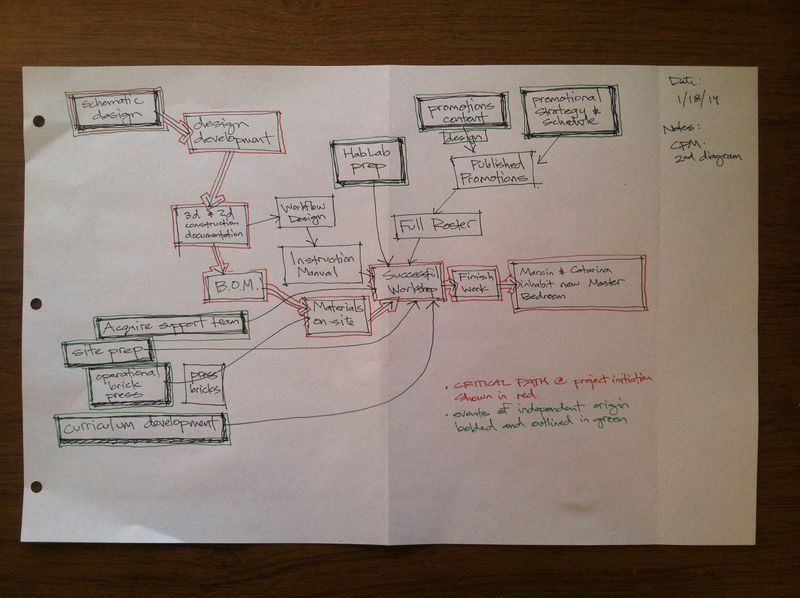
Documentation Efficiency at Workshops
This crossed my mind about how we can best facilitate the enthusiasts that attend our workshops in documenting the projects. When these people are only short-term guests at FeF or an off-site workshop, we lose too much time in installing apps on their mobile devices and trouble-shooting them. If we had iPad minis preloaded with the essential apps and also with instructional videos and tutorial documents, the devices become stand-alone tools that can be put in someone's hands to immediately kick ass at documenting.
Sat, January 18, 2014
CPM and PERT Research
For 2014, OSE will be using CPM and PERT tools to track our projects to facilitate better transparency between all collaborators, to ease and make more effective project evaluation, and to simplify the replication process.
CPM
Referenced these websites:
Also referenced the following book(s):
- Construction Management Jumpstart. Jackson, Barbara J. San Francisco: Sybex. 2004.
Critical Path Method (CPM) is sometimes also called Critical Path Analysis (CPA). Using it, one establishes the sequence of events and the time spans for each event. The sequence with the longest path through the network is the critical path. One new nugget of information for me is that the critical path can change throughout a project, so it is essential to monitor all of the tasks and not just those on what is initially the critical path. Most people choose to use activity-on-node (AON) diagramming (like Marcin has proposed), but some use activity-on-arc (AOA), also referred to as activity-on-arrow diagramming.
CPM begins with a clear list of specified activities, sometimes called Work Breakdown Structure (WBS), which is a listing of each activity with tasks and subtasks. "The WBS provides the foundation for all project management work, including, planning, cost and effort estimation, resource allocation, and scheduling" (Tutorialspoint.com. Work Breakdown Structure )
For scheduling, CPM uses the following time values:
- ES = Early Start = Earliest a task can start given that its precedent activities must be finished first.
- EF = Early Finish = Earliest a task can finish which equals its early start time plus the duration of the task.
- LS = Late Finish = The latest a task can be finished without delaying the project.
- LF = Late Start = The late finish date minus the duration of a task equals the latest a task can start without delaying the project.
"CPM was developed for complex but fairly routine projects with minimal uncertainty in the project completion times. For less routine projects there is more uncertainty in the project completion times, and this uncertainty limits the usefulness of the deterministic CPM model. An alternative to the CPM model is the PERT project planning model, which allows a range of completion times to be specified for each activity" (Netmba.com. CPM - Critical Path Method).
PERT
Referenced these websites:
Essentially, PERT is a more agile version of CPM, accommodating uncertainty in activity durations. Calculations to derive expected completion times are based upon equations that use optimistic completion time, likely completion time, and pessimistic completion time for each activity.
Similar to CPM, PERT begins with a detailed list of activities and sub-activites (WBS) followed by a sequence that places these activities into dependencies with one another to determine the paths.
Fri Jan 17, 2014
Establish Blackout Dates for April Workshop
It is important to me not to miss large events at my son's school. Other than that, my only April commitment is TEDxBloomington.
- Fri, April 4: Multicultural Day at Harmony School
- Fri, April 25: TEDxBloomington rehearsal
- Sat, April 26: TEDxBloomington
I propose the dates of Friday, April 18th - Wednesday, April 23rd. Workshop would begin on Evening of Friday April 18th. One option is that people can come for just the weekend - Fri eve through Sun eve. Second option is that people can come for 5 days - Fri eve through Wed eve.
- Price for two day workshop $195.
- Price for five day workshop $895.
Thu Jan 16, 2014
Marcin and Catarina's thinking about their home upon their return from honeymoon:
Here is a sketch exploring two further design ideas: 1) courtyard walls enclose exterior patio space, and 2) the pit greenhouse could wrap to the east side, too, creating two different greenhouse micro-climates.
Based on my meeting with Jody the other day, here is a visualization of current thinking about a major event at Ball State University.
Some themes are becoming apparent in the various conversations with professors and administrators at the universities. Here are some visual notes on those patterns.
Early 2014
Been looking at various ways to refine the design/construction of the MH. I've been generating ideas for implementation at both FeF, as well as at Baby Creek and other off-site workshops.
MicroHouse Design Ideas
Catarina's ideas for expansion of MH 1.
Here are some bird's-eye perspectives of two different ways of creating that floor plan.
Based on these ideas, I made some perspective sketches to get a better sense of what the space might feel like.
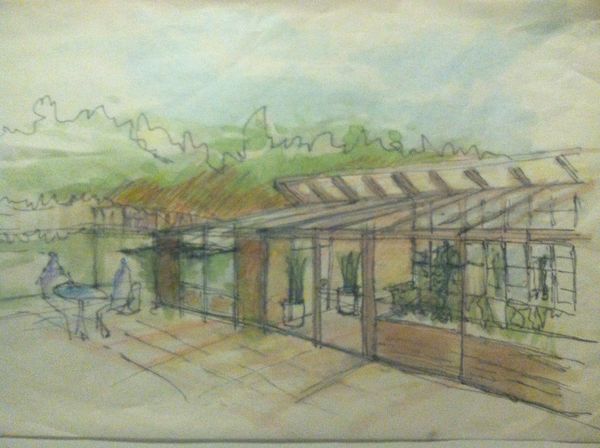
This image shows the courtyard space enclosed for the colder season. The north side of the courtyard is mostly glass to create a strong connection between inside and outside as well as creating a meeting/dining area this is filled with light.
Courtyard shown without trellis. Deck/porch shown off of west side.
Here are a few sketches showing various layouts for the master bedroom module. The first has the bed on the ground floor and is simply a large open space. The second adds a closet behind the bed. The third shows the bed in a loft and the ground floor left as a large closet space plus additional, more private living space. I think this is the preferred arrangement.
As we look at various roof framing options for the next modules, we will explore advantages/disadvantages of the gable roof. From a construction perspective, I think there are both positives and negatives.
Here is a design that uses the gable roof with a post-and-beam structure:
Here an addition is shown that creates a semi-private outdoor living space:
Also excited to begin exploring ideas such as this, where the rigidity of the grid is broken up with other forms to create interest and hierarchy among spaces. Using the grid for most modules, and occasionally breaking it, is a great way to celebrate certain spaces and create visual excitement.
MicroHouse - Increasing Speed
As we aim to increase speed but maintain quality, we some of the following challenges:
I believe that our next iterations of the MH should use a post-and-beam frame that allows us to put up the roof first. This would allow work to happen on multiple levels at one time, making better use of a full crew of two dozen workshop enthusiasts.
By having people begin work on the roof immediately, we not only quicken the pace of building, we also insure that the roof gets done before the workshop is complete - this creates lots more breathing room for the workshop facilitators. Putting the roof on last can create an enormous stress for facilitators if for some reason the workshop is not moving along as quickly as expected. Leaving a workshop host with a roofless building is a recipe for the building never being completed.
MicroHouse Building Workshop Development
The philosophy guiding the MH workshops is "Learn by Making. Learn by Documenting. Learn by Collaborating." We teach people how to do things with their hands, empowering them to shape their world. We teach people how to create instructions that others can follow, turning students immediately into teachers and reinforcing the hands-on learning. We encourage the enthusiasts that attend our workshops to be more than passive recipients of skills - we encourage and support them becoming collaborators on any of our openly developed projects.
Curriculum outline and scheduling for MH workshops can be found here: https://docs.google.com/document/d/12P_vbREkTTASV-vEamZfb47zVXZsxv1pAZHIjuu2F2c/edit?usp=sharing
For three reasons I feel like the first three MH workshops should be held at FeF: 1. Need for upgrades is paramount with Catarina's arrival. 2. FeF workshops allow us to work out the bugs on our home turf before taking the show on the road. 3. Early-season workshops at FeF give time to complete FabWagon.
Here are the first three MH workshops to run at FeF: 1. April: Master Bedroom Module on Marcin/Catarina's home. 2. May: Cody-Build 3. June: Pair to Cody-Build.
Baby Creek workshops will begin in May, with the "in-between" site of my own property. 1. May: Outdoor Kitchen 2. June: Master Bedroom Addition 3. July: TBD
Off-Site Workshops: 1. July: Russ Purvis at BC Ecovillage 2. August: Tyler in GA 3. September: 2nd at Tyler in GA or alternate site
LA471 Class
John Motloch's LA471 class is still on-board and excited about working with OSE to develop a master plan for FeF. I have been in touch frequently with John over the break as we make decisions about how to proceed with the planning process throughout the semester. The 471 class collaboration is also very exciting to Jody, department chair, and she would like Marcin to spend some quality time with the 471 students during his visit in the spring.
I am meeting with John on Tuesday Jan 14th to discuss my initial presentation to his class, which is scheduled for Tuesday, January 21. John has been provided with our current programming document as well as the site plan that were worked on between Marcin, Catarina, and myself.
In my initial contact with the class, I will give them an overview of OSE and FeF. I will show a handful of short videos, taken from the TOP 5 recently posted on facebook. I will focus much of my presentation on OSE's goals and needs for the current building season and also help them understand the long-term vision for the property.
MEETING NOTES: 1/14/14
John has 13 students in his class. They will be taking the first two weeks for introductions to each other and to the course materials. Students have been sent links Marcin's TED talk and instructed to watch it. The idea of maker-culture has been introduced to the class. They will be first looking at connections between people and place - using examples from around the world where people live a resource-based lifestyle.
After hearing this, I suggested that in addition to working on master planning for the FeF site, that students imagine on other sites around the world what an OSE facility might look like. John likes this idea very much. My question now is if we could/should pair the student teams with actual "clients" around the world from our network that may be interested in visualizing an OSE facility in their location.
I will be meeting with John's class on Tuesday, January 28th, to give them an overview of FeF and get them up to speed on our current planning efforts and our goals, both near and far.
Ball State Event
Much good progress here. Expanding the program to potentially include 3d printing workshop, as well :) Meetings on Tuesday the 14th and Wednesday the 15th to work out more details.
Right now, the plan is for a week-long (5-day) event. Every day includes hands-on activities as well as presentations/charrettes. The players are Marcin, myself, and ideally Jeff, from Lulzbot to facilitate the 3d printer workshop. Marcin will kick-off the brick press build, and Chris will continue it. Marcin will deliver a keynote presentation. Chris will deliver a presentation on the MicroHouse and facilitate several charrettes for the MH design - each focusing on a different element: construction management and extreme manufacturing, modular design, and sustainability. If we can arrange Jeff and Marcin's time to overlap, then it would be wonderful to have a panel between Mahesh Daas, the architecture chair, and Marcin and Jeff with a focus on open development.
MEETING NOTES: 1/14/14
Jody is still very excited to collaborate on an event that benefits as many students as possible and helps further the vision of "the back 40" at Cooper-Skinner Farm. We are looking at a speaking engagement with Marcin on either March 17 or April ? as the first step in a series of events over the next year, culminating in a design week or similar week-long event in the fall of '14 which itself leads into a competition followed by a build. After the first event, the sequence of competitions and builds can be ongoing as the Back 40 continues to be refined and developed. Open source hardware provides the maximum learning potential in bringing these visions to reality by allowing the student to go as deeply as they would like to into the relationship of humans to machines and to the land. Business, economics, and entrepreneurship students and faculty can also benefit by being exposed to open development philosophy and process.
Jody has reached out to a colleague in Construction Management as the first step to make the event interdisciplinary - and increase the available pool for funding. We will be reaching out to the other departments mentioned in the coming week.
As a parallel project, I believe that Ball State represents an ideal place for our first off-site 3d printer workshop, and potentially laser cutter workshops (or even CNC torch table workshops) down the road. The design world is the target market, and architects in particular, for 3d printers. Students and young professors, as well as many of the older ones, are captivated by the technology... and rightly so. Being able to make any shape into a physical model is a game-changer for architects. Anyway, I have a meeting on Wed, Jan 15th with Michel Monoyaur, the Assistant Dean who handles all the equipment purchasing, about running a workshop based around the TAZ kit and ideally getting a 3d printer into every architecture studio room.
Brick Press Sales
Several more exchanged emails with Scott M. He had a check mailed by one of his colleagues. It took several phone calls to finally get ahold of Shirley. She is going to double-check the mail, but does not believe she has received it. Waiting to hear back from her.
Sent emails to the two other inquiries regarding the brick press on the Product Interest List spreadsheet. If neither of them is interested, I suggest we post on facebook that we are doing an initial production run of the Beddingfield edition of the Liberator, and we have room for one more order.
Year End 2013
Notes
I went from being told I have the "model log" to going dark. If anyone actually reads this, my apologies... It bothers me on a personal level, too. I get a great sense of satisfaction from scrolling back through the previous work - I enjoy seeing everything that I have accomplished it serves as a great repository for previous decision-making. I am making this entry in early January. I will get the log caught up with the work that is happening in the new year, and then make some entries for the work that happened at the end of December, as well.
Dimensions for Building Remodeling
As part of improving the visitor experience to FeF and building a world-class facility, we will be upgrading existing experimental buildings to new uses. Here are the dimensions for the solar cubicles, the hexayurt, and the space in between them.
The solar cubicles will become two toilet rooms - connected to the prototypes of the vermi-shitter! The hexayurt roof will be re-used as the roof for an outdoor kitchen space.
Passive Heating/Cooling Infographic with Jean
As another component to the graphic presentation of the MH, I have been developing a graphic to explain the passive heating and cooling approaches used in the MH.
My comments for Jean...
His response:
After the following round of comments, he came up with this:
We are really getting somewhere now! Just a few adjustments, and we'll be there!
Wed Dec 11, 2013
Kakwa Ecovillage - Russ Purvis - Wants a 1 month event - kickoff of Tractor, Brick Press, and Microhouse. Best dates: May followed by Sep Oct or June. Northern British Columbia. Farmers in area. Molly at U. Minn - tool design workshop. Ball State February for week-long event - Jody dep't chair Architecture.
Wed Dec 4, 2013
Piping Diagram for Connection by Huts
Valve on HabLab side of tee connection gives control over how MicroHouse and HabLab are fed - either by county water supply or well water supply.
I would use the same detail here with the 4" PVC pipe as a sleeve to feed a homemade key into to open/close valve. I am not sure that we have enough valve on-hand for all this work, though. May need to get another valve. If you need any other plumbing supplies, call Mike at A & R plumbing. Their number is 816-232-5453. They seem to have flexibility in prices that they offer. When I called them to order the rolls of polypipe, they gave me a different, higher price, by $36 per roll. I said, "Yesterday, I had the price of $142.40 per roll." They asked who I had been talking to and I told them Mike, and Mike said he had was able to offer us the lowest wholesale price. However that works, I would talk to make sure to talk to Mike and to remind him he has given us the wholesale price in the past.
Last time, they also delivered for free because the rolls were too big to fit into Katie's car. Perhaps they would deliver for free again if there were several items on the order.
Again, Mike is the man at A & R: 816-232-5453.
Mon Dec 2, 2013
Piping Diagram for MH Supply with Yard Hydrant
Having the shut-off valve upstream from the yard hydrant allows the hydrant to be a hook-up point for evacuating the MH plumbing. If valve is between the hydrant and the MicroHouse, there is no good way to hook up a compressor to blow out the pipes.
Sat Nov 30, 2013
Notes from Skype Meeting with Ecolodge
Had a fantastic meeting this morning with two (Nico and Thibaut) of the core team from Ecolodge, an open source start-up in Belgium. We are very much on the same page from a philosophical perspective, and there are many overlaps with our business models, too. I believe that both short-range and long-term, our organizations can mutually support each others' work. Here's some specifics from my meeting:
- Ecolodge is creating a set of open source designs for prefabricated, modular, DIY architecture.
- They see three markets for their product:
* DIY market: these people use the open source designs to create their own Ecolodge start-to-finish
* kit market: this market purchases the prefabricated panels from Ecolodge and then assemble the kit themselves
* turn-key market: these individuals pay Ecolodge to build the panels and assemble them
- The DIY market drives innovation and creates exposure and publicity for Ecolodge.
- The kit and turn-key markets generate revenue for Ecolodge.
- Belgium is a country of 10M people. 1M of these people are self-employed, and many of them work from home. The market for backyard office spaces is huge.
- Often, the prefabricated components must be carried through buildings to get to the backyards - this puts a constraint on module size.
- Component dimensions are between 1m to 2.5m.
- In Belgium, if the building is less than 15 m2 (about 160 ft2), it does not require a building permit.
Ecolodge has a big deadline 10 days from now, when they present at a small start-up pitch session. There are four other groups pitching, but Ecolodge is the only one doing something so tangible. The others are more tech/software focused. They will have their designs complete by then, and are going to share them directly with me. Can't wait to see it :)
Here is a rendering from their facebook page of their v1 design:
Here is their video. I asked them if they can do a English-subtitle version, and they are going to work on it.
Ecolodge - Le Concept from demside on Vimeo.
Tues Nov 26, 2013
Meeting with Ecolodge (Belgium) Guys Scheduled
I noticed a like from "Ecolodge" on one of the MH posts. Clicked on it, and it is an open architecture start-up in France. They are creating a modular, open source house and then commercializing it.
I sent them the following letter, in my broken French:
"Bonjour! Mon francais n'est pas bien... il y a longtemps que j'ai parlais. Je suis tres interessant en votre travail. Je suis le Architectural Lead et Construction Manager pour Open Source Ecology. Je voudrais parler avec vous! Mon email est chris@opensourceecology.org. Merci!!"
They contacted me, and yesterday I set a meeting with three of their core group on Saturday. Looking forward to hearing more about their work. Their website is under construction right now, so it's hard to find details about their project.
Potential Workshop Client Spreadsheet - 2014 Schedule
Created a list of those that I am in conversations with about workshop hosting. I have sent emails to them asking to schedule phone calls next week to begin getting the most serious inquiries booked into the calendar.
See also 2014 Schedule.
Monday Nov 25, 2014
Created Microhouse Collaboration 2014 Page
Because people have started sending me design ideas for the MicroHouse development, I formed a page on the wiki where all these ideas can be stored by subject matter. I will also add my own in-house research to this page. A link was also added on the MicroHouse 1 Development Board to this collaboration page.
http://opensourceecology.org/wiki/MicroHouse_Collaboration_2014
Partnership with BSU CAP Landscape Architecture Department
Enjoyed a lengthy planning session today with Jody Naderi, Chair of the Landscape Architecture department in the CAP. She is very excited about collaborating on two inter-related projects:
1. Lecture + Brick Press Build
- Bring Marcin to BSU CAP for a lecture
- Lecture kicks-off a brick press build for CAP to add to their fabrication arsenal
- The lecture, the build, and having an operational brick press on-site all generate excitement for #2
2. Interdisciplinary Design Competition
- Architecture, Landscape Architecture, and Construction Management
- MicroHouse + regenerative edible landscaping design
- Construction management workflow design for swarming construction
- Living Building Challenge 2.1 as metric for sustainable design
My next step is to create a written proposal for Jody in order to move the process forward.
Sunday Nov 24, 2014
Simplified Development Timeline Graphic Created
This simple document can help the ED and DPVs come to a clear understanding of the development timeline for a specific product. When more than one project is occurring simultaneously, these documents can be printed and hung up side-by-side so everyone can easily check the timeline of any project at a glance.
Tom Mallard's Small Home Ideas
Thanks, Tom, for posting these ideas to the OSE facebook page in response to the MicroHouse infographic. Your design is very cool!
Here's what Tom had to say about it:
"This is a 10ft x14ft tiny home with a loft that's active solar-thermal using the roof as the heat-cold source and water thermal-mass in pipes below the floor & in the high wall, toilet & gray water on separate piping and drinking water collection from rain to a cistern.
A patio roof folds down in winter on the north side, floor plan has built-ins a lot of shelving the table drop to a dbl bed, room for another in the loft that has a lot of drawer storage, ladder to it not shown."
Fri Nov 22, 2013
Proposed Work Plan for December
- ensure completion of MicroHouse to move-in condition
- furnish and stage MicroHouse for architectural photography
- take architectural photos of MicroHouse
- evaluate old workshop/greenhouse for new social hub
- create detailed execution plan with ED for infrastructure improvements for 2014
- create program (designer's term for what activities will happen in a space) for the entire FeF site with ED
- source MicroHouse client from current pool of applicants and newfound reach on facebook
Social Spaces and Amenities to Improve DPV experience
I have been part of two parallel conversations with Marcin and others recently: one is regarding cleaning up the old shop and the other is providing some awesome amenities for FeF visitors. A space doesn't have to be expensive to be awesome, and with the lack of social life in any neighboring town, DPVs need a place to unwind, relax, have a drink and socialize with each other while playing games. Essentially, I propose we turn the old workshop and greenhouse into a new bar/lounge/venue space. We redo the greenhouse and add a hot tubs like Marcin brought up. A kick-ass versions of the DIY trough style with stove underneath. There's a lot of great precedents out there for these. We see what the best ideas out there are, so if we can improve it, and make one OSE style.
The brick space on the north side is the lounge area. The ping-pong table can be permanently set up. We build a small stage so that presentations can be given to larger groups. A pool table would be awesome. A small bar. Since there is really nothing to do in Maysville or St. Joe, we need to create something to do right there. Eliminates driving - with both the loss of time, the money spent, and the risk of accident.
If on the weekends and in the evenings, DPVs can really unwind together, more people will want to spend more time at FeF. There will be a tighter bond between the group. Everyone will produce more during the work hours, too, because the chance for burn-out goes down significantly. A standard and disciplined schedule for work-time, and built in play time with all the accommodations to really do so.
The space doubles as educational space for workshops and large-group events. We can host speakers and talent shows on the stage... movie nights, too. We need a nice, big drop down screen. We need to build a sweet little stage and decorate it. I actually know the DPV that will do this and he recently asked me to come to FeF - Whitney Stump - he is the proprietor of Be Here Now, a pub and music venue in Muncie, IN. He has done numerous stages. We worked together on these projects most recently, where I built the earthen walls and he built the roofs.
I will take photos of the stages when I am back in Muncie this weekend. I think we need a hip space for people to hang out in, and we need to do it at a low cost. Whitney has been doing that for years at his venue. I'll talk to him about a visit. I know he wants to come.
With a decorated stage setup, Marcin, Catarina, and all the rest of us can give talks from a real stage, even if they are broadcast remotely.
Link to Chris Reinhart Log Archive
All work from Thu November 21, 2013 and previous can be found at the archive of my log. This keeps load times on my current log page much faster for you and I both :) http://opensourceecology.org/wiki/Chris_Reinhart_Log_Archive
